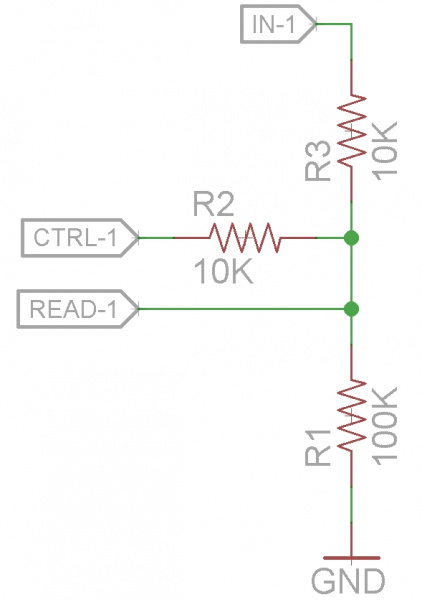Constant Innovation in Quality Control
Pre-Testing for Jumpers
In July of 2013, we changed from testing the IOIO OTG with a raw input power of 9V up to 15V. This was to ensure that the board would work for our users at even larger input voltages.
This also lead to killing a lot of our testbeds. We eventually found that if there was a short to ground on any of the power rails (on the IOIO board under test), it would usually fry the testbed and the board. Our immediate fix was to have our technicians use a multimeter to check for shorts to ground on all of the power rails. Although this enabled us to continue building and testing IOIOs, it was not the most efficient way to pre-test. We knew there must be some way to automate this pre-test.
So, one afternoon, I told Pete Dokter about our troubles, and he helped us come up with the following test. It basically uses a voltage divider to measure a line and see if it has a jumper to GND.
It requires two pins from your micro: a control pin (digital) and a read pin (ADC). By manipulating the control pin HIGH and LOW, and watching the voltage on the read pin, we can know if the input pin (the power rail in the case of the IOIO) is jumpered to GND.
If the IN-1 net is grounded, then the READ net should sit at roughly 1/2 of CTRL-1 (logic level). Combined with the power control of a high side switch, this allows us to avoid powering up a board that has a jumper to GND, and ultimately saving the board-under-test and the testbed from potential damage.
Here is the function we use to test for jumpers on the latest IOIO testbed:
language:c
boolean jumper_test(int control_pin, int read_pin){
digitalWrite(pre_testing_led, HIGH);
pinMode(control_pin, OUTPUT);
pinMode(read_pin, INPUT);
digitalWrite(control_pin, HIGH);
delay(200);
int reading = analogRead(read_pin);
if(debug){
Serial.begin(9600);
Serial.print("\t reading:");
Serial.print(reading);
Serial.end();
}
pinMode(control_pin, INPUT);
int jumper_val = 486;
digitalWrite(pre_testing_led, LOW);
if((reading < (jumper_val*1.05)) && (reading > (jumper_val*0.95))) return true; // jumper detected!!
else return false;
}
We have always put PTC resetable fuses on our testbeds to prevent damage when current spikes, but adding this pre-test is a great way to ensure that the current never surges in the first place. This issue had never come up on previous tests because most of our products require very little current. This means that when we test a board, we can limit our power supplies current (most of our tests call for 200mA). The IOIOs, on the other hand, require much higher current for testing the charge circuit. They actually draw up to 800 mA when charging our tablets.
Although it was kind of painful to see so many testbeds bite the dust, it was ultimately a good thing because it pushed us to make even better testbeds. We now have an extra tool to use for high current products!
